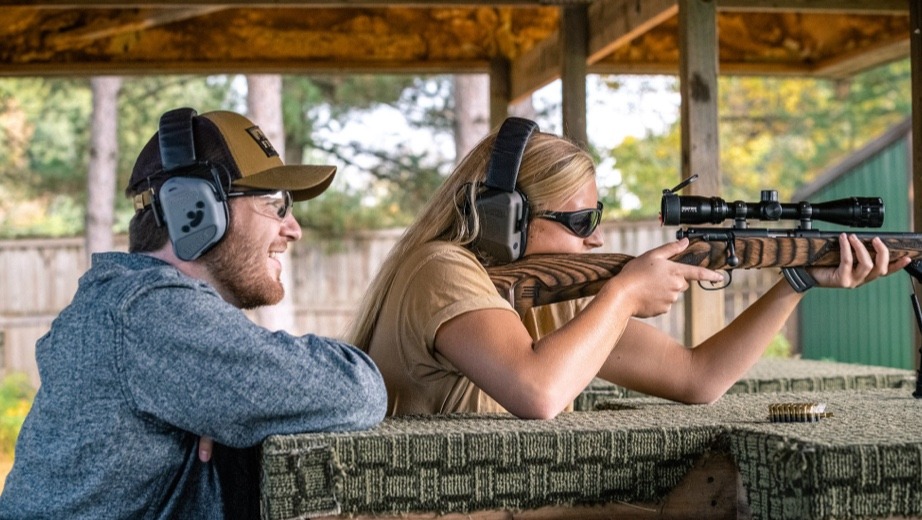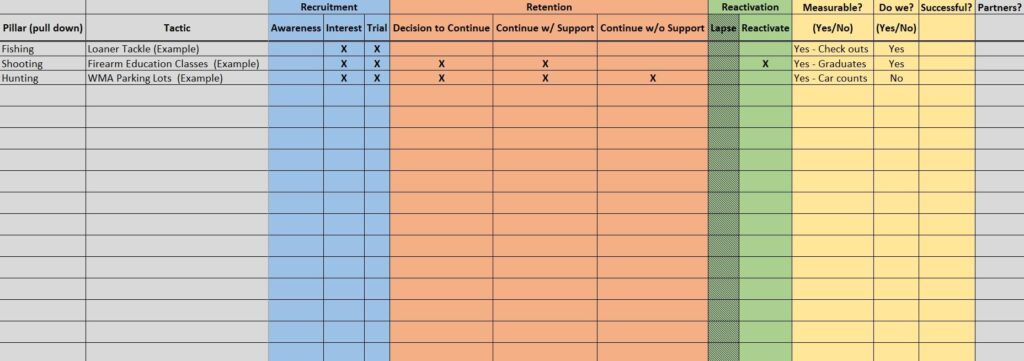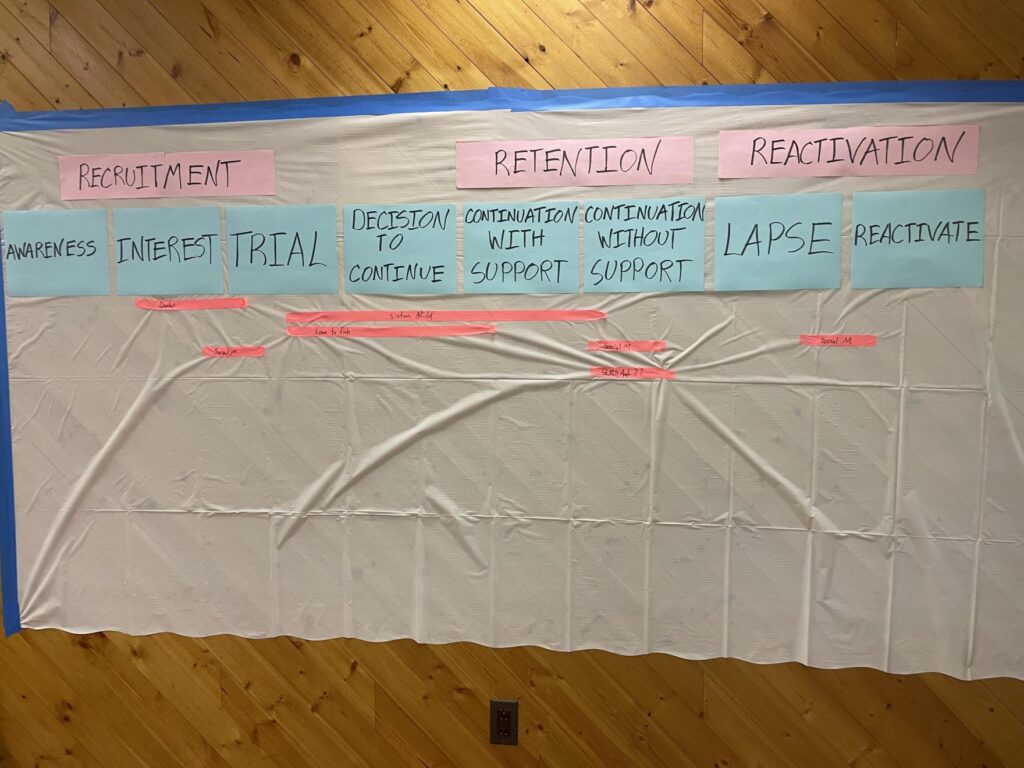Planning and Strategy
What is it?
Planning means different things to different people. But at its heart, planning is simply a systematic, comprehensive approach to identifying:
- What you want to accomplish.
- How you intend to accomplish it.
- Specific ways/metrics you will measure whether (or to what degree) you have succeeded over time.
Recognize that:
- It is possible to achieve R3 outcomes without having a formal plan.
- Having a plan in place only provides better results if it is well-built and well-implemented.
Experience shows that effective plans make it much more likely for an organization to achieve its R3 outcomes.
Anyone involved in planning will tell you the process is often just as important (sometimes more important) than the document. Involving the right people and being realistic about every step in the process can empower an organization to make tremendous strides toward achieving R3 outcomes. A good plan can also provide the structure and guidance to empower the R3 Team to say no to ineffective or redundant tactics and strategies.
Speaking of the Team, there are often several different levels of teams engaged in the R3 planning process. For purposes of this Practitioner’s Guide, we use the following loose definitions:
- R3 Team – the core group of people who are specifically assigned to conduct R3 work (R3 practitioners).
- Planning Team – the group assigned to develop the R3 Plan. This group almost always includes the R3 Team but is likely to have additional members who are not R3 practitioners.
- Writing Team – the group of people assigned to write the plan document—to put the planning team’s work into words. Members of this team are usually assigned by subject area, e.g., separate author(s) for hunting, shooting sports, or other activity areas (fishing, boating, etc.).
Why is it important?
There is an old saying: “If you don’t know where you’re going, any road will get you there,” and indeed, “Every road will get you there.” The R3 enterprise is a perfect example of this. For decades, organizations have done “R3 work” without clear plans to guide them—without goals, objectives, and methods for determining whether they are achieving their goals. With the ongoing decline in hunting license sales, the R3 community can no longer afford to take such a shotgun approach.
A solid plan can also be a powerful protection against mission creep. When the next “great idea” comes along, you can hold it up against the plan to see if and where it fits. If it doesn’t fit, you have a strong foundation for pushing back against adding it.
The planning process aids in engaging internal staff and external partners in planning for and contributing to a shared future, creating a structure for accountability and reporting, and a way to celebrate and track accomplishments.
How can your organization help its practitioners?
- Allow/encourage staff to spend time creating and implementing an R3 Plan.
- Ensure the R3 Planning Team has broad representation across the organization.
- Empower the R3 Planning Team to engage appropriate staff across the organization.
- Show the R3 Planning Team how/where the R3 Plan fits into the broader organization mission/strategic plan.
Engaging Leadership
Real-world experience across many agencies and organizations shows that supportive leadership is critical to the ultimate success of R3 planning efforts. Without strong leadership support, staff will assume that R3 efforts are the responsibility of the R3 Coordinator or other specific staff assigned to “handle R3.” This is the worst-case scenario—the exact opposite of effective R3 planning and implementation.
An R3 Coordinator could indeed draft an R3 plan for the entire agency or organization without anyone else’s involvement. And that would pretty much guarantee it would not be implemented. A key factor in developing an effective plan is to get input and buy-in from across the organization. This is challenging to accomplish without clear support and direction from leadership.
If you have been tasked with the development or revision of an R3 plan, one of the first steps in your process should be to ask for a meeting with leadership—starting with your supervisor but including as many leaders as you can and as high up the chain as you can go. Ask them for direction and support. The leadership of some organizations have sent messages and even video messages to all staff, stating that an R3 Plan is being developed, that a coordinator has been tasked with guiding the effort, and that leadership wants staff to make R3 a priority. Alabama, Kentucky, and Texas have run internal “I am R3” campaigns. Support from top-level management is great, but if your organization is large enough to have a middle layer of management (bureau or section chief, etc.), try to involve them as well. If you can secure mid-level support, there is less chance that support for R3 work will dry up if changes happen at the top.
By their nature, comprehensive R3 efforts cross divisional boundaries and require assistance from across the organization. For many people, the lift will not be significant (many are doing R3 work already, even if not by that name). Still, a single person can create a logjam for large efforts if they don’t recognize the task as being part of an organizational priority. Support and communication from leadership can go a long way toward gaining and sustaining cooperation across the organization.
In addition, your efforts can be much more consistent and less susceptible to sudden changes if R3 is “baked in” to your organization’s structure and function. As you engage leadership and prepare to conduct an R3 planning process, check out the chapter on Organization-Wide Buy-In, which covers these topics in more detail. Building a broad base of allies and support for R3 across your organization is critically important to the plan’s ultimate implementation.
Hunting, Fishing, Sport Shooting, and Archery Recruitment, Retention and Reactivation: A Practitioner’s Guide
Provides a guide towards improving planning and cooperation among R3 Partners. Ch. 6
Setting Up Your Organization for Change

Organizational buy-in begins with a strategic approach that integrates your organization’s R3 goals and objectives and the involvement, insight, and perspective of the staff impacted by the plan–especially those who have the influence and expertise needed to deliver R3 efforts. Broadly, the following steps outline how an R3 practitioner should work toward achieving organizational buy-in:
Begin with understanding your organization’s current R3 efforts, programs, and strategies. Program mapping against the Outdoor Recreation Adoption Model is a valuable tool to visually assess the R3 impact of your organization.
- Assess current hunting and shooting sports participation among the populations your organization serves. For example, review hunting license or shooting range permit purchase reports, previous research from expert groups or institutions, and any participant survey data that may exist within your organization or its partners.
- Identify which staff, expertise, leadership/authorities, and sections/divisions/departments have a vested interest in, or will be impacted by, R3 strategy implementation.
- Conduct a listening session with identified staff to learn about their concerns, perspectives, or ideas relative to R3. Use this information and work with them to craft high-level R3 goals and visions.
- Develop an R3 plan (or at least a strategic guidance document or process) that integrates individuals who can represent the various perspectives, concerns, and wisdom of the staff engaged in the previous step. Allies and champions that may have emerged in the earlier efforts should be prioritized for this work. Identify performance metrics for both the strategic plan and organizational buy-in.
- Create a long-term communication plan for R3 efforts. This allows you to share R3-related accomplishments and progress across the organization. Give staff frequent opportunities to learn about R3 and the organization’s approach to it.
- Develop R3 training opportunities for staff involved directly in R3 and for everyone interested in R3.
The following resources provide additional and more detailed guidance on implementing the above change management process.
Building Internal Buy-In
Facilitators guide for Building Internal Buy-In offered by the Council with Justin Grider and Peter Novotny at the 2023 National R3 Symposium.
Change Management Process (Harvard Business School)
These are the key 5 steps in creating organizational change. A systems thinking approach.
Faction Mapping by Kansas Leadership Center
A template to identify what the key values, loyalties, and perceived losses are among factions engaged in and impacted by your change management process
Mapping R3 Efforts on the Outdoor Recreation Adoption Model
An overview of how to use the ORAM to map R3 efforts. Helps agencies create buy-in by visualizing R3 program and efforts.
Recommendations and Strategic Tools for Effective Angler Recruitment, Retention and Reactivation (R3) Efforts
This program evaluation guide was designed for aquatic educators. However, much is readily transferable to any R3 effort. Provides insights for setting up your organization for change.
Ohio Division of Wildlife Law Operations Changes Charter
This is a sample Wildlife Law Operations Charter from the Ohio Division of Wildlife.
Identify Planning Team
There is a common saying among the R3 Community that “R3 is everybody’s job,” but every successful planning effort needs a leader to ensure it happens. For most state agencies, that will start with the R3 Coordinator. Some private organizations also have R3 coordinators or may have another position tasked with leading R3 efforts. Even if the organization does not have a formal R3 Coordinator position, it will be very important to identify a single person who can fill that role. Many people will be involved in building a solid R3 Plan, but there needs to be a single person who leads the charge and holds others accountable. See the (LINK) Staffing and Personnel chapter for more details about specific skill sets to look for.
Because all states implement R3 differently, CAHSS has assembled descriptions of how four states structured R3 in their organization.
Once a coordinator (or someone who can play that role during planning) is in place, the next step is identifying a planning team to assist. Ideally, this planning group would have broad representation from across the organization. It would be made up of individuals with a personal interest in R3. Some additional characteristics to look for in team members:
- Diverse expertise and experience (broadly representative of organization staff)
- Diverse racial/ethnic/cultural background (broadly representative of state/region)
- Capacity to assist (allowed/encouraged to spend time on the planning effort)
- Detractors/Opposition/Resistant Personnel (It is important to get their perspectives and their buy-in to the process. These team members may be the most challenging but often provide the most valuable perspectives.)
You should be prepared to tell prospective planning team members what the task entails and what is expected of them (planning horizon, number and frequency of meetings, potential assignments, etc.).
When to involve external partners
Across the country, federal, state, and local government agencies and a wide variety of private organizations and industries are working to achieve R3 outcomes (although not always by that name and quite often completely unaware of each other). Bringing these efforts together prevents or minimizes duplication of effort. At best, it synergizes all efforts. The question is when to involve external organizations in your planning process.
Some organizations have planned using the “big tent” approach—identifying and inviting everyone to the table at the very beginning.
Advantages:
- You get a good idea of what efforts are ongoing, where interests lie, and, therefore, what strategies you can likely leave to others when you get to the implementation phase.
- You (hopefully) generate interest and buy-in from a large group of stakeholders long before it’s time to implement.
Disadvantages:
- You cannot control what external organizations are going to do. You likely have little recourse if an outside organization misses a deadline that you were counting on.
- The planning process may bring out internal problems, personality clashes, or capacity issues that you may not want to air in a public forum.
Although the “big tent” approach can work, facilitators who have helped multiple organizations conduct R3 planning generally favor a stepwise process where you complete internal planning first. This allows you to identify what your organization is currently doing, what you are good at, and what you want to do more of before integrating with other stakeholders. Finally, any unavoidable pauses in the planning process are much easier to manage and less likely to damage the overall effort if handled internally before engaging external stakeholders. The “Statewide R3 Collaborations” section of the CAHSS website offers additional insights.
Ultimately, the R3 Coordinator should work with leadership to determine which approach offers the most benefits. Regardless of approach, you should create a relationship with the Council to Advance Hunting and the Shooting Sports (CAHSS) and the Recreational Boating and Fishing Foundation (RBFF) as you begin. Both organizations have insights and resources that can help you throughout the planning process—including a review of your final plan document.
CAHSS R3 Topic Guide “Organizational Culture”
This resource offers guidance to help organizations build their R3 team and select a coordinator.
Best Practices Workbook for Hunting and Shooting Recruitment and Retention
One of the earliest comprehensive tools for hunting and shooting recruitment and retention (R&R). It will help identify team members for effective R&R. Pg. 33-57
Hunting, Fishing, Sport Shooting, and Archery Recruitment, Retention and Reactivation: A Practitioner’s Guide
Helps identify gaps in personnel and considerations for planning team needs. Ch. 6
Try, Test, Learn, Adapt: The Massachusetts Approach to R3
This is a webinar from The Massachusetts Division of Fisheries & Wildlife. Learn about their Try, Test, Learn, Adapt process, which guides them in their efforts.
Muster Resources
Effective plans are ongoing but should be based on the best available information and examples. Fortunately, a LOT has been tried and learned over the past ten years, with more results coming out every day. But don’t jump too far too fast! Everyone wants to immediately conduct efforts to “get more hunters and shooting sports participants.”
That’s great, but if you are assigned to develop or revise a hunting/shooting R3 Plan, the first step is to think strategically about it and to learn from others who have done the same.
Start by reviewing the resources in the table below. Take multiple days if you can and do a deep dive into these resources. There are even more planning resources available in the CAHSS Clearinghouse. Dig as deep as your time and commitments will allow before you begin.
You should also check out R3 plans that other agencies have produced. There is a list of these linked in the table below. A word of caution: you should never just take an existing plan and cut and paste your organization’s name into it and call it done. Your organization has situations, programs, people, and other factors that nobody else has. Much can be learned from someone else’s plan and experience. Still, there is no substitute for going through the planning process and building a plan that will meet your specific situations and needs.
As you review what others have done, talk to them, too! The Council to Advance Hunting and Shooting Sports has set up an online R3 Community full of R3 practitioners from around the country who are grappling with these issues every day. Everyone in this community is eager to share successes, failures, and ideas for how to do R3 better. Take advantage of that resource.
As part of your effort to muster resources, you should conduct a thorough inventory of the R3 programs and other efforts your organization is currently involved in. An excellent tool for helping with this process is R3 program mapping. See the separate section on program mapping in this chapter.
If your organization has any data on hunters and shooting sports participants (license sales data, range permit sales, program attendance, pre- and post-program survey data, etc.), now is the time to collect as much of that as possible, organized by as many demographic variables as possible. For state agencies, license sales data will be instrumental in identifying areas where your plan should focus. For shooting sports participants, range permit sales, user logs, and survey data would be beneficial. If you are in a state agency, at a minimum review the real-time license data at www.R3Dashboard.org. Even if your state does not yet contribute data to this national effort, the dashboard can be a good starting point to review trends of comparable states or regions.
NOTE: In many situations, R3 practitioners have great difficulty accessing these data. Often there are legal, administrative, and political barriers that must be navigated. Be prepared to engage senior leadership to help you with this—and do it early. These data are critical to conducting effective R3 work.
Best Practices Workbook for Hunting and Shooting Recruitment and Retention
One of the earliest comprehensive tools for hunting and shooting recruitment and retention (R&R). It will help identify necessary resources. Pg. 33-57
Hunting, Fishing, Sport Shooting, and Archery Recruitment, Retention and Reactivation: A Practitioner’s Guide
This entire document contains an expansive compilation of survey and assessment results broadly related to R3 efforts.
CAHSS R3 Topic Guide “Statewide Collaborations”
This resource provides guidance for planning statewide R3 collaborations.
Hunter Recruitment, Retention, and Reactivation
This web page offers an abridged history of R3 and some key ideas for hunter recruitment, retention, and reactivation.
List of Existing R3 Plans
List of existing R3 Plans currently housed on the R3 Clearinghouse.
Mapping R3 Efforts on the Outdoor Recreation Adoption Model
An overview of how to use the ORAM to map R3 efforts. Helps approach, plan, evaluate, and implement R3 goals.
National R3 Implementation Workgroup Interim Report
The results of a 24-chair, five-month R3 implementation workgroup. Identified needs across R3 initiatives and provides primary items needing resources.
Program Mapping Worksheet
An Excel spreadsheet template for mapping existing R3 programs against the ORAM.
R3 and the Outdoor Recreation Adoption Model
This one-sheet explores R3 and the ORAM at a glance for new and existing R3 communities.
R3 Toolkit—A Guide to Recruitment, Retention and Reactivation.
This toolkit is divided into three topic areas: defining the R3 situation, an introduction to the Outdoor Recreation Adoption Model (ORAM), and examples of R3 programs.
Try, Test, Learn, Adapt: The Massachusetts approach to R3 (55 min.)
This webinar includes an in-depth description of one state’s R3 program evolution and evaluation of their Learn to Hunt clinics. Assists R3 practitioners in identifying crucial resources.
Frameworks and Standards for R3 Effort and Strategy Evaluation
An in-depth study and resource for program evaluation from planning to identifying useful metrics.
Ohio Division of Wildlife Law Operations Changes Charter
This is a sample Wildlife Law Operations Charter from the Ohio Division of Wildlife.
Program Mapping
An essential step in program development is understanding what R3 work your organization is currently involved in. You can skip this step if you are building an R3 program from scratch. However, most organizations are already doing something, even if some of it is not officially designated as R3. While it might be a minor task for some organizations, this will be significant for some. One of the keys to successful R3 efforts is to provide interventions for hunters and shooting sports participants at every stage of the Outdoor Recreation Adoption Model (see Foundations & Definitions if you’re unfamiliar with the ORAM). Most R3 efforts are aimed at the Recruitment stage of the ORAM, and those are vitally important, to be sure. But if all we do is get people to their first trial of the activity and never impact their journey again (which is, arguably, what we’ve been doing for a couple of decades), our efforts will not, on average, create the lifelong hunters and shooting sports participants we are trying to create. This program mapping exercise will help you understand what stage(s) of the ORAM you are currently addressing and where there may be holes you (or your partners) may need to fill.
Program mapping helps logically visualize and condense an organization’s program offerings. A program mapping worksheet is available for review in the table of resources.
Program mapping is a simple tool to identify strengths and gaps in your R3 programming. To use the chart, let’s look at the blank sections of the program mapping template.
Section one includes a pillar column and a tactic column:
The pillar column lets us know what subject we target with this row. In this case, the first row targets shooting R3, and the second row targets hunting R3.
The tactic column includes examples of existing R3 efforts. Firearm education classes are an example of a programming area, while WMA parking lots are a relevant example of addressing access.
Next, let’s look at these tactics concerning their role in R3 with the recruitment, retention, and reactivation columns. As we advance, we will focus only on our programming example.
As you can see, we place an X within the boxes that the tactic addresses. Firearms Education Classes can address aspects of all three R’s related to R3 efforts. This is a strong example of why programming for R3 is so essential and will be addressed later in our programming section.
When you use this program mapping chart, fill the chart with as many of your current programs as possible. This will help you develop an accurate picture of your programming efforts. Then, you can use this chart to identify strengths and gaps in your programming.
Strengths in your programming efforts are the columns where there are many Xs. Gaps in your programming initiatives are columns with fewer Xs.
There are a few other issues to consider when analyzing your program offering:
Available Resources
If you have available resources, add new R3 efforts to address gaps. If you are short on resources, you may have to cancel one program to free up resources to add another.
Public Interest
Public interest in hunting and shooting sports varies over time. If you offer programs that aren’t attracting many participants, it may be time to look for more popular topics.
Barriers – What is preventing new participants from coming to the activity? Could you address this issue in a program and enable more people to participate?
Motivations
What motivates a person to consider the activity? Consider offering programs designed specifically for potential participants with each of those motivations.
Target Audience
Offer programs for a specific target audience (women, teens, seniors, etc.)
Locations
Offer your programs in more than one city so that different people have the potential to attend. Ideally, offer the programs where you know there is a demand for that particular program.
Partners
Work with partners to offer programs they feel are important or that they are particularly well suited to deliver.
A webinar with complete instructions for the program mapping exercise can be seen here:
Mapping R3 Efforts on the Outdoor Recreation Adoption Model
An overview of how to use the ORAM to map R3 efforts. Helps visualize and evaluate your R3 programming.
Program Mapping Worksheet
The program mapping worksheet is a method of visualizing and identifying strengths and gaps in agency programming.
Create a Plan Format and Process
One of the first things you should do as you prepare for the planning process is to assign a facilitator. Most organizations that have been through the planning process report that they got better participation, engagement, and honesty from their teams when they were able to bring in a “third party neutral” facilitator to manage the process. Look for someone with facilitation training, not the R3 coordinator or anyone central to the plan’s content.
In the world of planning, there are dozens of terms used to describe the various aspects and hierarchical levels of plan topics (goals, objectives, strategies, actions, tasks, etc.). It doesn’t matter what you call your plan’s various levels or sections so long as everyone responsible for implementing the plan knows and understands the terminology.
Following is a very commonly used R3 planning structure with simple definitions of each level/section.
GOALS
OBJECTIVES
(attach metrics and target audiences)
STRATEGIES
ACTIONS
TASKS
Each level is nested beneath the level above it and contributes to the achievement of the levels above. For instance, in this example, completion of all the objectives in your plan will bring about the achievement of your goal(s). Strategies are the things that have to happen to achieve your objectives. The further “down the chain” you go, the more your plan shifts from strategies to tactics (or operations).
Goals – what are we trying to achieve with the R3 effort? What is its purpose? These are usually very high level and often are purposefully vague (i.e., you typically don’t add numbers or dates at this level).
Some common examples of R3 goals include:
- Increase participation in shooting sports
- Increase hunting license sales (this is often a metric for participation, but some use it as a goal)
Generally, you wouldn’t want to have more than 3 goals. Some states only have one goal, and they build out the details in objectives, etc.
Objectives: Specific things you want to accomplish to achieve the goal(s). This is where you add numbers and dates and try to make each objective “SMART.”1
Specific
Measurable
Actionable
Realistic
Time-bound
An example of a good, “smart” objective might be: “Reduce the churn rate of hunting license buyers to XX% by 2020.”
It tells exactly what you’re trying to do, is easy to measure (assuming electronic licensing systems are in place), and has a specific target date for completion. Creating good, smart objectives is usually the most challenging part of the plan-writing operation, and it is where teams should spend the bulk of their time and effort. If you get the objectives right, everything else flows from that reasonably easily.
Before building out the Strategies, Actions, and Tasks beneath the objectives, we strongly encourage R3 planning teams to identify target audiences and metrics for every objective.
- Target Audiences – at whom are our efforts directed? There really is no such thing as the “general public.” The more specific you can be at identifying who you are trying to impact with a given objective, the more effective your efforts will be. Get off to a good start by attaching one or more target audiences to each objective.
- Metric – how will we measure success?
- Some objectives are “easy” to measure, such as the number of licenses sold. Others are very “mushy” and hard to measure, like participant satisfaction. But by forcing yourselves to identify metric(s) for each objective (and then measuring!), you will ensure that your efforts achieve the ends for which you designed/implemented them.
- Strategies/Actions/Tasks – nested layers of “stuff” must be completed to achieve the objectives. Many R3 plans currently “on the street” are primarily strategic; they don’t go much beyond goals and maybe objectives levels. Other states are trying to make their plans more tactical or operational. It doesn’t matter where you want your plan to stop adding detail—the most important thing is to be sure that your planning team shares a similar expectation about it. Most people want to go right to the actions and tactics: What must I do tomorrow and next week to make this happen? It’s great to finally get to that place, but doing it systematically and strategically will make the entire enterprise much more effective. And that’s the whole point of strategic R3 planning.
Timeline and Process
The time required to develop a comprehensive R3 Plan is extremely variable, depending on circumstances. Many organizations allocate a year or more to the process. The process itself isn’t unusually complicated or time-consuming; however, assembling a diverse team of very busy people and facilitating a collaborative process just takes time.
It is challenging to predict the specific steps that might be required for any organization to complete an R3 plan, but the following is an example that contains the steps commonly recommended.
Best Practices Workbook for Hunting and Shooting Recruitment and Retention
One of the earliest comprehensive tools for hunting and shooting recruitment and retention (R&R). It will help identify how to develop a plan and process. Pg. 33-57
Hunting, Fishing, Sport Shooting, and Archery Recruitment, Retention and Reactivation: A Practitioner’s Guide
Help guides plan format and process, especially considering evaluation. Ch. 2
Locavore.guide
Great effort goes into developing a locavore hunting program, getting it approved, staffing it, and training new hunters. Though locavore specific, this guide is applicable for all program planning.
Open Standards for the Practice of Conservation
This resource is a core text for teaching the Open Standards for the Practice of Conservation (ALC3128) course.
CAHSS “Start with a Solid R3 Foundation” Video Series 4. Best Practices for R3
This video explains some of the best practices in R3. Excellent foundational training material.
Change Management Process (Harvard Business School)
The 5 steps to go through in change management. A systems thinking approach.
R3 Plan Template
DJ Case & Associates adapted some basic planning terms into this R3-specific outline, which also serves as a template for drafting an R3 plan document.
SMART Objectives
This 2 page article summaries Doran’s system for setting SMART objectives.
Try, Test, Learn, Adapt: The Massachusetts approach to R3 (55 min.)
This webinar includes an in-depth description of one state’s R3 program evolution and an evaluation of their Learn to Hunt clinics.
Communicating Your Plan Within the Organization
Different organizations have different processes and protocols for communicating the R3 Plan to staff. The key is to recognize that this is a critically important step! To a large extent, the degree to which the Plan will succeed or fail is the degree to which it is shared with and accepted by your fellow staff—especially any staff who play direct roles in implementation. Your planning team should take the time to identify every staff member who will assist in implementing the plan. Then figure out how to communicate with and take input from those people/positions. The worst possible way to begin implementation is to have the freshly minted plan land on the desk of some staff member who is expected to take some action but has never heard of or had input into the plan. You might consider having facilitated discussions in workshops, webinars, or personal meetings with selected staff to share the plan and next steps.

Of course, when you ask for input from a broad, diverse group of people, you are likely to get broad, diverse responses. You may need to follow up with individuals or groups about their input. Fear or concern about roles/assignments is a common reaction. Help them understand what the plan proposes and set mutual expectations. People will want to know why the various elements were selected and how they relate to them and their jobs. This takes time, and often it has been overlooked or ignored, but it may be the most important step as you shift from developing the plan to implementing it. Plan to spend some time here, and take whatever time is needed to do it well. Be prepared to share the process you used and why various decisions were made. You will likely never get 100% acceptance. Still, people will be much more likely (and even eager) to collaborate if you have listened to them and made a good-faith effort to address their concerns.
It is also very important to involve your communications division early in the planning process. Communications staff are often very busy, handling issues from all over the organization, often on very short deadlines. Let them know what you are doing and when you expect it to be done, and seek their input on how to get it into the staff’s hands most efficiently and effectively.
Implementing your R3 plan, tracking progress
Although this is a chapter on R3 plan development, a few important thoughts on implementing the plan are in order here.
When R3 Plans (or any kind of plan) fail or “sit on a shelf and collect dust,” it is almost always because no one was assigned to track progress and follow up. Even if the plan is very tactical and has specific assignments and deadlines for the strategies and actions, if no one is looking to see if the assignments are met, who will know and who will care?
Consequently, one of the most important parts of the planning process is to assign a person or a team to track progress, send reminders, and generally hold staff accountable for the plan elements they are responsible for. Too often, organizations do not make arrangements for this at all, or maybe the task is loosely assigned to the planning team without any direct instruction or authority to do it well. Don’t let the planning process end without a specific process to track and report accomplishments. To this end, having written records of progress, completion, and next steps is often helpful. Several such templates are listed in the table of resources below.
For more detailed information on evaluating your plan, see Evaluation and Monitoring.
SDGFP Education Plan: Progress and Management
Sample template of a form that managers can use to track progress, completion, and next steps of R3 plan working groups.
SDGFP Simple Objective Tracking Sheet
This resource is a simple objective tracking sheet that helps visualize, focus, and assess progress on agency objectives.
Frameworks and Standards for R3 Effort and Strategy Evaluation
An in-depth study and resource for program evaluation from planning to identifying useful metrics.
Nebraska Hunting and Shooting Sports R3 Plan
To maintain support and funding for our agency, we must keep our customers engaged while actively recruiting new individuals to participate.
Revising Your Plan Over Time
All plans, by their nature, are (or should be) “living” documents. They are mechanisms of adaptive management. They provide guidance in the short term but should be reviewed and updated regularly based on real-world experience.
With each passing day, more and more agencies and organizations that have R3 plans in place gain experience implementing them. If good objectives were set and evaluation is taking place, this experience shows where changes could be made to make R3 efforts more successful and/or efficient.

Specific situations will vary widely, but early experiences suggest that a good way to begin a plan revision process (or any planning process) is to ask the following questions:
- Is someone responsible for reviewing the plan over time? (No single person should have to complete the review alone, but should have authority and responsibility for ensuring it takes place.)
- Do we have control over the objectives and strategies we identified?
- Did we take on too much? Can we prioritize?
- How effective and reasonable were the metrics we identified? Were we able to collect that information?
- Did our teams have the right people engaged? Did we miss key players?
- Did we get organization-wide buy-in? Are staff implementing their tasks?
- Is leadership still supportive?
- Have we engaged external partners? Is there an opportunity for more?
State Agency Insights into R3 Planning: Version 2.0
This presentation describes Iowa’s R3 planning journey and helps identify the pathways that their state agency is taking for version 2.0 of their R3 plan.
Frameworks and Standards for R3 Effort and Strategy Evaluation
An in-depth study and resource for program evaluation from planning to identifying useful metrics.
- Doran, G. T. (1981). “There’s a S.M.A.R.T. Way to Write Management’s Goals and Objectives,” Management Review, Vol. 70, Issue 11, pp. 35-36. [↩]








 massmonopoly
massmonopoly R3 PRACTITIONER’S GUIDE
R3 PRACTITIONER’S GUIDE